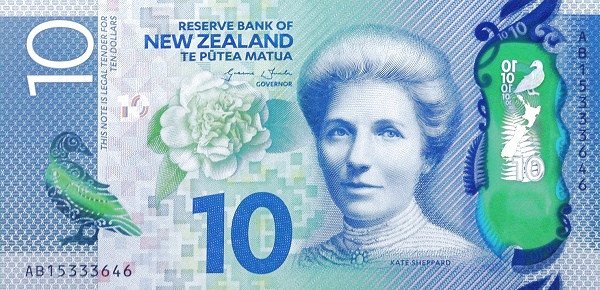NZD/USD continues to lose steam below 0.5750 amid market jitters in advance of China’s trade balance release and US Nonfarm Payrolls (NFP) announcement. The pair ends its four-day losing streak, trading at around 0.5730 in the Asian session. Meanwhile, international trade events, such as Trump’s exemption of Mexican and Canadian imports from threatened tariffs and Canada’s slowdown in retaliatory tariffs, are still influencing market sentiment. The US labor market remains strong, with initial unemployment claims falling and NFP to increase to 160K in February. Besides that, China’s promise of more stimulus and a dovish move from the People’s Bank of China have assisted somewhat in support of the New Zealand Dollar (NZD). But fears surrounding US policy uncertainty and possible Fed rate actions deter the strength of the US Dollar, placing the NZD/USD currency pair in a subdued trading band.
KEY LOOKOUTS
• China’s trade balance report is followed closely by traders, which has the potential to affect NZD sentiment considering that China is New Zealand’s largest trading partner.
• The anticipated increase in US job additions to 160K has the potential to affect Federal Reserve policy expectations and influence the strength of USD against NZD.
• Market sentiment is affected by Trump’s tariff exemptions and Canada’s postponed retaliatory tariffs, influencing risk appetite and currency fluctuations in the forex market.
• Promises of additional stimulus and possible rate reductions by the People’s Bank of China would help support the NZD, offsetting overall market uncertainties.

NZD/USD continues to be pressured as investors wait for major economic releases, including the release of China’s trade balance and the US Nonfarm Payrolls (NFP) report. Market mood is influenced by continued global trade news, such as Trump’s tariff exemptions on Mexico and Canada and Canada’s postponement of retaliatory tariffs. In the meantime, hopes of more stimulus from the government of China and the dovishness of the People’s Bank of China lend some strength to the New Zealand Dollar. But US policy uncertainty fears and the prospect of the Federal Reserve responding to slowing economy and inflation keep the US Dollar down, keeping the NZD/USD currency pair in a cautious range.
NZD/USD is trading with caution below 0.5750 as the market looks to China’s trade data and the US NFP report. Global trade events and China’s stimulus plans drive sentiment, with uncertainty over Fed policy holding back the USD.
• The pair is under selling pressure ahead of major economic data releases, as market caution prevails.
• Investors are extremely careful watching China’s trade data, which has the potential to affect NZD due to China being New Zealand’s biggest trading partner.
• The employment market is likely to improve, with payroll additions climbing to 160K, having a bearing on USD strength and Fed policy expectations.
• Exemptions of Mexican and Canadian imports from potential tariffs under the USMCA affect global trade sentiment and risk appetite.
• Canada delays its second round of tariffs on US goods until April 2, lowering near-term trade tensions.
• Pledges of further economic stimulus by Chinese officials help support NZD with concern over global economic growth.
• Expectations in the market move towards possible action by the Fed to curb economic slowdown, influencing movement in USD in the forex market.
The market scene is still influenced by global economic events and policy measures, shaping investor perception and currency movement. Ahead of the release of China’s trade balance figures, market players are watching closely for its possible implications on international trade and economic expansion. With China being New Zealand’s biggest trading partner, any change in the dynamics of trade may have spillover effects on the New Zealand economy. Furthermore, the United States’ performance in its labor market is also being eyed, with the next Nonfarm Payrolls (NFP) due to provide some clues about trends in the employment market and the overall stability of the economy. These events reflect the interlinkages between economies around the world and why such economic indicators need to be closely tracked.
NZD/USD Daily Price Chart

Chart Source: TradingView
Finally, policy announcements from major economies also have a big impact on market sentiment. The United States’ recent waiver of Mexican and Canadian products from threatened tariffs under the USMCA lightens trade tensions, while Canada’s hesitation on retaliatory tariffs adds to a stable trade atmosphere. In the meantime, China’s agreement to further stimulus measures indicates an activist approach toward maintaining economic growth, supporting confidence in its market policies. While central banks and governments deal with these economic woes, their actions will keep driving financial markets, business plans, and global trade relationships.

TECHNICAL ANALYSIS
NZD/USD is in a cautious range, unable to build steam above significant resistance levels. The pair recently put an end to its losing streak near 0.5730 but has resistance at the 0.5750 level. A continued break above this level may pave the way for additional upside, while support on the downside is seen around 0.5700. Moving averages reflect a bearish to neutral bias, with sellers in control unless there is a breakout. Furthermore, momentum indicators like the RSI and MACD reflect a lack of strong bullish conviction, leaving the pair susceptible to additional consolidation in the near term.
FORECAST
NZD/USD may experience a rise, particularly if China’s trade balance figures are better than expected or if additional stimulus is introduced. A robust US Nonfarm Payrolls (NFP) report would also enhance risk appetite, thereby indirectly favoring commodity-sensitive currencies such as the New Zealand Dollar. Technically, a move above the 0.5750 resistance level may pave the way for additional gains, with the next stop being around 0.5780–0.5800. A softer US Dollar, fueled by speculation of Federal Reserve policy changes, would further enhance the pair’s bullish momentum.
To the downside, NZD/USD is exposed to bearish forces in case of disappointing Chinese economic statistics, which would trigger concerns of decelerating worldwide trade. An upbeat US NFP reading would further solidify the Federal Reserve’s hawkish bias, firming up the US Dollar and exerting bearish pressure on NZD/USD. If the pair cannot stay above the 0.5700 support level, further losses towards 0.5670 or even 0.5650 may be witnessed. Also, persistent geopolitical risks or trade tensions may dampen market sentiment, resulting in additional risk-off factors for risk-sensitive currencies such as the NZD.







